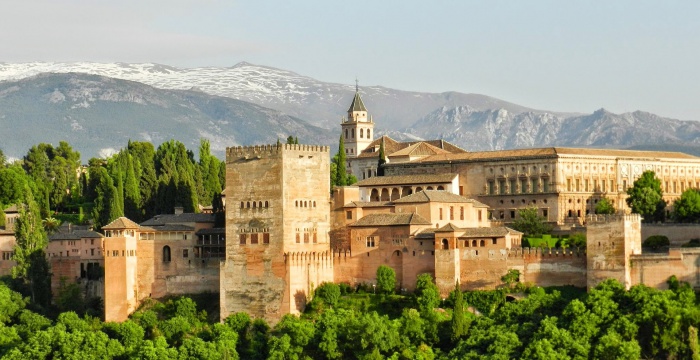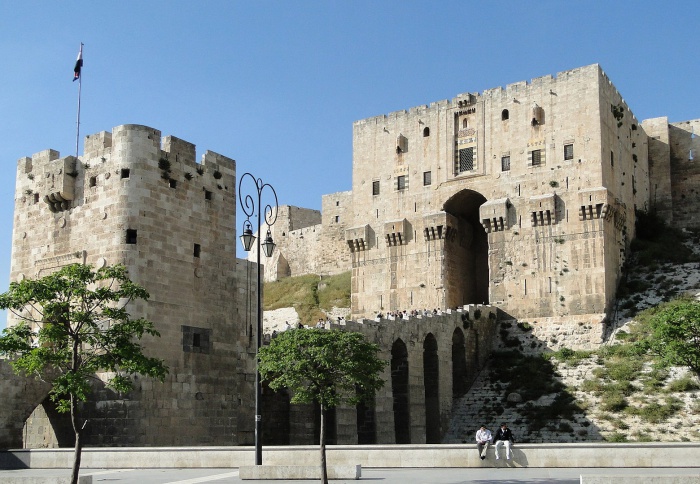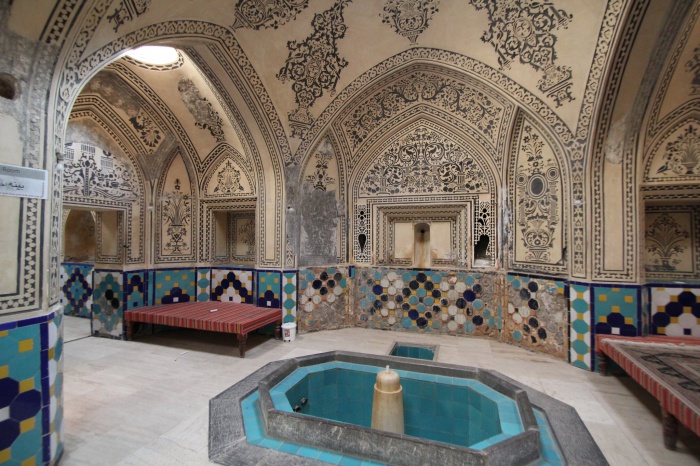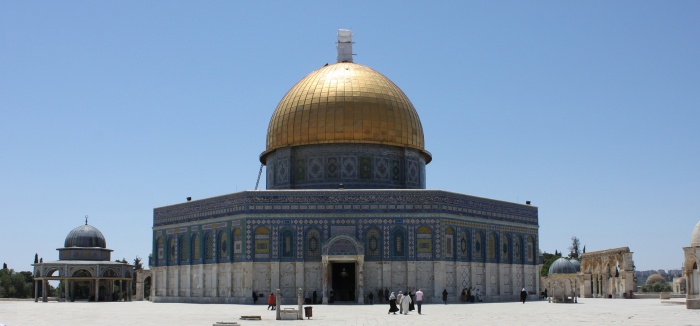1. Alhambra, Granada, Spain
The Alhambra is a palace constructed by the princes belonging to the Muslim Nasrid dynasty of the 14th century. Unfortunately, over time some parts of the palace were destroyed. Nowadays only three parts are left: the fortress (Alcazaba) at the western end of the hill, which resembles the princely residence in the East, and a group of pavilions and gardens known as Generalife. You can easily define the inner courtyards and spaces of the Alhambra: they are beautifully decorated with colored tiles, geometric shapes, carved wood and impressive calligraphy.

Alhambra, Granada, Spain/Pablo Valerio/Pixabay
The palace complex consists of a series of apartments, halls and courtyards, united in a common delightful concept. The palace is an architectural masterpiece in every aspect. Sequences of spaces are clearly defined by boundaries and each space contains identical features.
Visual effect reaches its peak due to careful selection of color, light and pattern. The palace was constructed using not only plaster, but also cellular vaults, muqarnas, stalactites and faience – these are the substances that cover all the walls, floors and ceilings. The composition of courtyards, gardens and ponds represents the Muslim vision of the Paradise they want to achieve.
Honey juice, which they will quench their thirst with in Paradise, is symbolized as a honeycomb vault in the Hall of the Abencerrajes. It is probably the most breathtaking vault in the world. Here one can find the intertwining of small rhombus-shaped ledges, which are separate cells that look very much like honeycombs. These “honeycombs” are located around the eight-pointed star, which has 16 windows on each side, which lets in a huge amount of light that can even blind for a short period of time.
Paradise rivers are represented with four streams, which originate in the central fountain of the Court of the Lions. They are also the springs for the rest of the numerous reservoirs in the palace. The basin of the Court of the Myrtles is one more “river” that stretches to the eastern side of the palace. Art historians correlate gold moldings and calligraphic ornamentation covering the walls (especially the apartments where ambassadors from different countries were received), with golden jewelries and silk dresses promised to believers in Paradise.
It is hard to overestimate the influence of the Alhambra architecture and style in the spread of the Muslim Moorish style. Wealthy Europeans, who heard of it or were honored to visit it, could not resist the idea of reproducing it completely or, at least, some of its elements in their own palaces. For instance, it is enough to remember Owen Johnson (809-1874) and his exorbitant fascination with Muslim architecture in general. The influence of the Alhambra Court of the Lions on his perception of the world was reflected in his work “Alhambra Court in the Crystal Palace of Sydenham”. Decorative and interior decoration of the Alhambra has left its mark in most European houses, especially in Victorian England. It is enough to read Victor Hugo's “Les Orientales” in order to understand how much the influence of Alhambra on Europe was.
2. Citadel of Aleppo, Syria
One of the most impressive works of architecture in the Middle East is the citadel, which is located at the top of the hill in the center of the Syrian city of Aleppo. This example of Islamic military architecture will not leave anybody indifferent. Some of the fortifications, found by archaeologists, date back to the Roman epoch and even earlier.
Inside one can find houses, warehouses, wells, mosques and defensive constructions – everything, which was necessary in order to hold out during a war or a long-term siege. The tremendous entrance block, built in 1213, is the most impressive part of the building complex.

Citadel of Aleppo, Syria/Bernard Gagnon/GFDL 1.2
The citadel of Aleppo is an example of the richest historic heritage of Syria. The 50-meter high hill, at the top of which the citadel rises, has both natural and artificial origin. Its top was alternately crowned with Aramaic and Hittite temples, ancient Acropolis, buildings of Byzantine and Muslim epochs.
According to the excavations of archeologists, the first settlements that appeared here one can date to the middle of the III millennium BC, and probably even to earlier period of time. The temple of God Haddad is mentioned on the cuneiform tablets from Ebla in Halab. The first fortification was constructed here by Seleucidae that got Syria after division of Alexander the Great’s authority by Diadochus. Aleppo, which had been given the name Berroia at that time, was being constructed according to the Hellenistic sample. There was a marketplace (Agora) and a temple in the center of the town. The wide straight street with a colonnade led from the Agora to the main gate in the West. On the Eastern side, on a steep hill, there was the Acropolis, the predecessor of the present citadel.
In 637, Aleppo came into the hands of Muslims without any fight. Under the rule of the Umayyads (661-751) and later Abbasids (750-1258) the town became a large trading center, where the trade routes connecting the Mediterranean coast and Iraq, southern Syria and Asia Minor met. The Byzantines tried to conquer the town several times. In 944 there was established an independent ruler, the famous warrior Sheikh Saif al-Dawlah (945-967), the ancestor of the Hamdanid dynasty. In the year 1000, Aleppo passed under authority of the Egyptian Fatimids. Then there was established an independent Caliphate led by Seljuk rulers Mirdasids. Twice, in 1100 and 1103, Aleppo was besieged by crusaders, but they did not manage to conquer it. During the reign of Nur ad-Din (1146-1173), the founder of the Zengid dynasty, and then the descendants of the famous Salah ad-Din (1174-1193) - Ayybids, the town became one of the main centers of Muslim unity in the fight against the crusaders.
The citadel, like the town itself, was repeatedly damaged by earthquakes, destroyed by conquerors and then rebuilt. The greatest damage to the city was caused by Mongols of Hulagu Khan in 1260. They managed to do what the Crusaders had failed to do. The town was taken and strongly destroyed. Even the citadel, the palaces of which were burnt by the conquerors, fell. The residents of the town were killed or taken prisoner.
The Egyptian sultan Baibars crushed the Mongols, but in 1271 and 1280 invasions of terrible steppes repeated. In 1400 the town was brutally defeated again by Timur, who ordered to build a tower of 20,000 cut-off heads of defenders. The town was being restored after that defeat for more than a hundred years. When it was conquered by the Ottomans in 1516, it had only 50,000 inhabitants.
3. Sultan Amir Ahmad Bathhouse, Kashan, Iran
Sultan Amir Ahmad Bathhouse is a unique example of Persian architecture and unique decoration. It was constructed in the XVI century and now it is one of the most famous and popular tourist attractions. Geographically, the bathhouse is located in the historical district in Kashan. The roof makes the structure of the bathhouse quite special, as it is perhaps the most charming and artistically rich part of the building. No wonder that it is a popular place for photo shoots in different time of a year as it offers a number of breathtaking colors and angles. The bathhouse is registered as a site of the national heritage.

Sultan Amir Ahmad Bathhouse, Kashan, Iran/reibai/Creative Commons 2.0
The facade of the building itself is decorated with floral patterns, in the center of which there is a big open flower, the symbol of the divine presence in this world. The frieze is decorated with muqarnas, those unusual decorative protrusions. There is a bas-relief depicting a lion hunting a roe deer above the main entrance.
Behind the entrance there is a long winding corridor leading to the sarbineh dressing hall. It is an octagonal hall with high columns. On the column walls one can see well-preserved frescoes with paintings of French impressionists and bas-reliefs depicting birds, flowers and bright scenes from hunting life. There is a swimming pool in the middle of the hall. It used to be served as a place for washing visitors’ feet. There are benches along the perimeter of the room, where people used to relax over a cup of tea and have a measured conversation after the visit. The bath was lit by a small round hole in the ceiling.
Then there followed the next room of Hammam – so-called garmkhaneh, which is a hot room or steam room. It differs from the sarbineh in larger quarters and more modest surroundings. The room served as a place for washing and cleansing the body. The part of its walls is laid out using faience mosaic, which is an integral, traditional element of the interior of Persian culture. The vaulted ceilings are decorated with intricate geometric patterns.
The bathhouse floors are covered in marble. Since ancient times it had been used in many buildings, as that stone was quickly heated and kept warmth well. And besides, it possessed very important antiseptic properties.
4. Dome of the Rock, Jerusalem, Palestine
The oldest surviving monument of these times is the Dome of the Rock in Jerusalem – it was built half a century after the death of Muhammad. It is not only the oldest one but also, but also the most widely known. The dome was constructed in 691-692 that is about 55 years after the Arabs had conquered Jerusalem. The building consists of the luxurious wooden dome located on the top of the octagonal base. This place is sacred both for Islam and followers of Judaism.

Dome of the Rock, Jerusalem, Palestine/boubakar/Pixabay
If we return to historical records, we will notice at once that the first Jewish temple located on the Temple Mount, had been destroyed by the Romans who quickly built the sanctuary of Jupiter on the ruins. After its fall there appeared the Muslim temple that primarily was used as a hotel for pilgrims. In the Middle Ages, the building changed hands, and there was a cross or crescent moon on the top. At the end of the XII century, Saladin recaptured Jerusalem from Christians and turned the Dome of the Rock into the Islamic temple forever.
Since then, the mosque had probably experienced only architectural upheavals: every prominent ruler in the times of the Mamluke Sultanate or the Ottoman Empire considered it their duty to redesign the mosaic or add an unusual, previously absent in the interior detail. In 1927 the building was seriously damaged after the earthquake. It took several decades of assistance from Jordan and Turkey to restore the building.
There is a sacred place for all the Abrahamic religions in the territory of the mosque – the cornerstone. It is the starting point from which the creation of the world began. During the time of the first temple there was kept the Ark of the Covenant – the wooden chest covered with gold and containing 10 Commandments. Ritual sacrifices were made on the same stone. Some Jewish thinkers consider the stone to be too bulky for religious ceremonies, but even they believe that the stone foundation is located somewhere at the walls of the mosque. Muslims, in their turn, honor the stone as the place where Prophet Muhammad ascended to heaven, accompanied by angel Gabriel, and then returned safely.
If we pay our attention to the architecture, we will see that the building itself is a stocky octagon of marble, crowned with a shiny dome. Interestingly, the king of Jordan sacrificed 80 kilos of gold for the dome decoration. Europeans highly appreciated architectural merits of the mosque in the crusader era and borrowed its shape for many European temples. The Dome of the Rock also had a significant impact on the design of the mausoleum of Sultan Suleiman the Magnificent in Istanbul, the synagogues in Budapest and Berlin.
5. Suleymaniye Mosque, Istanbul, Turkey
One of the most fascinating attractions in Istanbul is the towering dome of the Suleymaniye Mosque complex. The mosque was built by the Ottoman Emperor Suleiman the Magnificent between 1550 and 1557. It is the biggest and the most impressive of all mosque complexes in Istanbul. The mosque was designed by the Ottoman master, architect Sinan and now it is considered to be the greatest of his works. There is a hospital, several religious schools, a number of shops, a mausoleum and a bathhouse around the mosque itself.

Suleymaniye Mosque, Istanbul, Turkey/Abdullah İçöz/Unsplash
By the way, a lot of legends are associated with the mosque. One of them tells us that once the ruler of Persia (he and Padishah Suleiman were at the stage of “cold war”) heard rumors that the construction of the shrine was dragging on. Then the Shah decided to mock the Sultan, ending him a gift of a large number of gems, diamonds and other precious stones, hinting at the lack of funds in the Ottoman Empire. Naturally, Sultan Suleiman was greatly offended by such a gift and in anger he gave the order to bury all the Persian jewelry in the foundation of one of the minarets.
The unsurpassed acoustics of the Suleymaniye Mosque deserves special mention. Of course, it is silly to suppose that people knew something about electricity or microphone at that time. Therefore, to achieve the existing acoustic effect architect Sinan invented a unique "move" - to mount special pitchers resonators in the walls of the Muslim temple. In addition, it became the reason for the emergence of one more legend. Once Sultan Suleiman was told that his main architect completely refused to build the mosque and did not deal with it and that he was doing nothing but relaxing. Such impudence angered the Emperor, and he went to the construction site to understand what was going on. Having arrived at the destination, Suleiman saw the architect sitting directly in the middle of the building with a nargileh in his hand, but he didn't smell like tobacco. It turned out that Mimar Sinan was just murmuring with water, checking the acoustics in the walls of Suleymaniye and carefully listening to how the sound spread along the perimeter of the sanctuary. Sultan was very pleased with what was happening and the architect was able to continue working on the project in peace.
Ilmira Gafiyatullina
Photo in the slider: Hesam.montazeri
